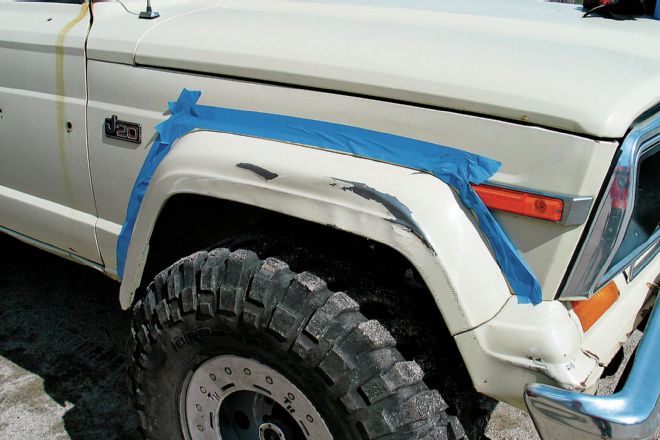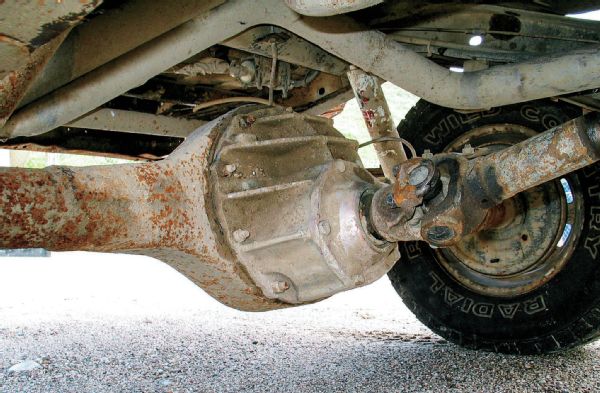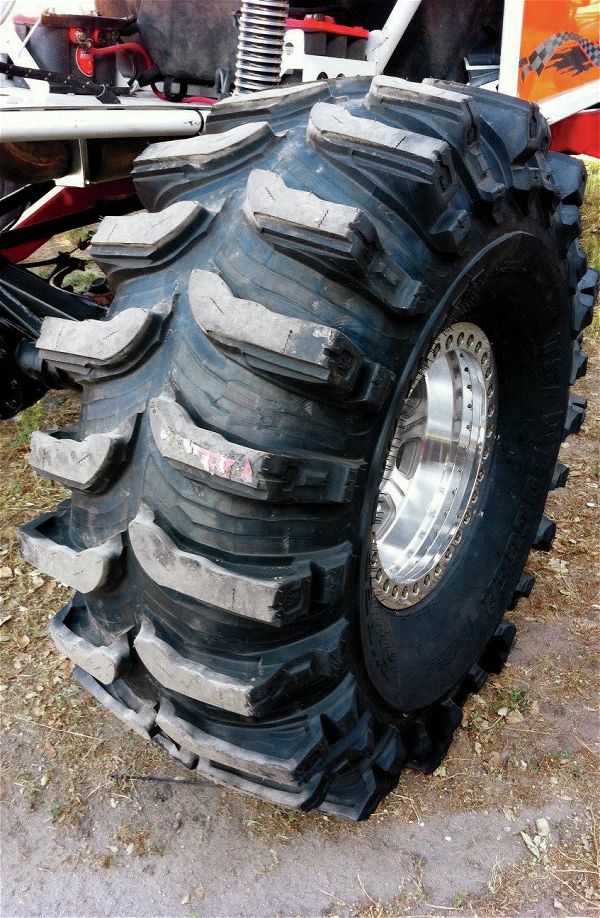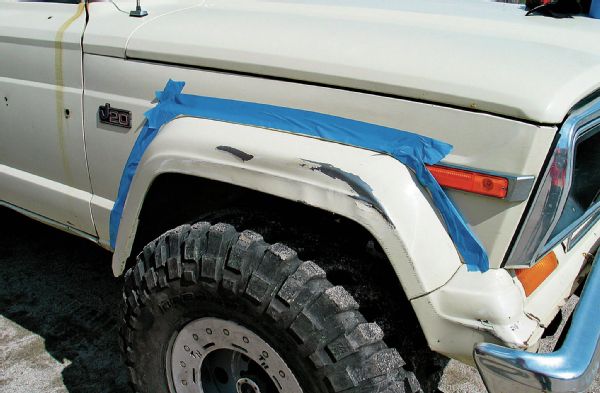
 John Cappa
Former Editor, Four Wheeler
John Cappa
Former Editor, Four Wheeler
Best Bronco Axle Swap
Q I have a ’89 Bronco with a Solo Motorsports long-travel suspension front and rear. It rolls on 36-inch tires. I’m worried about the stock 8.8-inch rear axle staying together. What would be a good rear axle swap for my Bronco?
Agustin Jimenez
Via email

A Some people chastise the Ford Twin-Traction Beam (TTB) 4x4 trucks. But, if you like racing across the desert or over rough patches of trail at speed, a solid-axle front suspension usually can’t compare to a modified TTB suspension. Most of these 1⁄2-ton TTB trucks have the Ford 8.8-inch rear axle. It’s not a total turd, but it does have its limitations. A good rear axle swap for the ’87-’96 Bronco and F-150 with an 8.8-inch is the Ford 9-inch that can be found in ’74-’86 Ford 1⁄2-tons and Broncos. The Camper Special, 4x4, and ’80-’86 Ford 9-inch axles are more desirable because they have 31-spline axleshafts. Some of the older two-wheel-drive F-150 trucks have smaller and weaker 28-spline axleshafts. It’s always a good idea to pull a ’shaft to make sure of what you are getting when wrecking-yard axle shopping.
The ’74-’86 truck and Bronco Ford 9-inch has many admirable qualities. All of these axles utilize a large Timken Set 20 bearing on the axle ends. This bearing is pretty much the aftermarket axle industry standard when it comes to flanged axles. It’s very heavy-duty. Another advantage is that you could conceivably upgrade any of these Ford 9-inch axlehousings with 35- or 40-spline axleshafts using completely bolt-on parts. Of course, 35-spline ’shafts are much more common and a far less expensive conversion. Another cool and unusual feature of the ’74-’86 Ford 9-inch is that the right and left axleshafts are the same length. You’ll only need to carry one spare.
If you are looking to match a widened TTB axle assembly, consider swapping in a 9-inch from a ’70s to ’80s Ford van. These axles are about 68 inches wide, versus the typical truck and Bronco Ford 9-inch width of 65 inches. Most Ford vans have 31-spline axleshafts.
Paddle Tire Tech
Q I have a set of 15x15 wheels and I want to make a custom set of paddles for my Jeep. I need a wide set of mud tires to start with. What tire carcass would you recommend I start with? What is the widest off-road tire you know of?
@iggy_nacio
Via Instagram @cappaworks

A Paddle tires come in two different types. There are vulcanized paddle tires and molded paddle tires. Vulcanized paddle tires are made using an old tire carcass. Different sized paddle cups are vulcanized to a tire that has been stripped of its tread. A molded paddle tire is a completely new tire that has the cups molded into the tread area. Choosing which is right for your application will depend on the tire diameter you are looking for and the kind of terrain you plan to hit.
If you are looking for a tire that is taller than 35 inches, you need to stick with the vulcanized tires. Currently, the largest molded paddle tire available is the Sand Tires Unlimited (sandtiresunlimited.com) Sand Master. It measures in at 351⁄2 inches in diameter.
Most vulcanized paddle tires are built on old drag racing slicks. The wider carcass provides more flotation on the soft stuff. The largest of the drag tire carcasses come from a top fuel dragster and max out at 36 inches in diameter. These are about 211⁄2 inches wide and require a 16x16 wheel. Smaller 33-inch-diameter drag slick carcasses that will fit on a 15x15 wheel are available. However, a drag slick carcass may not be the best choice for your 4x4. This will depend on the soft terrain you plan to encounter. Drag tires are designed to be light weight, which is good. Your 4x4 will have less rotating weight to contend with. On the downside, the sidewalls are pretty thin. Sticks and sharp rocks can easily pierce holes in the sidewall of an expensive paddle tire made from a drag slick. You have to change your driving style (no aggressive sideways power slides) and make sure the area is free from nails, rocks, and branches when using a drag-slick paddle. Most molded paddle tires have thin sidewalls too. So if you plan on running into more than soft mud and sand, you’re better off starting with a true off-road tire carcass.
If you need a paddle tire that is taller than 33-36 inches, you’ll need to find your own tire carcass. The paddle cups can be attached by a tire vulcanizing company such as Skat-Trak (skat-trak.com). In the past, companies like Skat-Trak would only vulcanize paddles to a bias-ply tire carcass. More recently, we have seen Skat-Trak paddles on 35x12.50R15 and 37x12.50R17 BFG off-road racing tires. So you might want to call the company to find out what you can use, prior to buying a tire core to start with.
Interco Tire (intercotire.com) offers many different ultra-wide heavy-duty tires under the Super Swamper line that might make good paddle tires. Check out the specs for the bias-ply Bogger and SX. There are some extra wide versions of these tires. You can sometimes find used Super Swamper tires for sale on eBay (ebay.com) and Craigslist (craigslist.com).
Keep in mind that just because your 4x4 fits 35-inch tires, doesn’t necessarily mean a 35-inch paddle tire will fit your 4x4. When fitting paddles, make sure that there is enough clearance for the tall paddle cups when your suspension is fully compressed. I have seen many people destroy expensive paddle tires and rip off body panels due to poor test fitting.
Another option is to start with a new Super Swamper Bogger and have it grooved and lightened into a pseudo paddle tire by Racing In The Dirt (racinginthedirt.com). The company offers three different competition cuts that can lighten a 44-inch Bogger by up to 50 pounds. The Bogger scoops are carved out and even look more like paddles than they do when new. You can supply the company with your new tires to be grooved, or you can buy the tires already grooved.
Blue Sky Waggy
Q Back in the mid-to-late ’80s, Four Wheeler published a how-to article on grafting the factory Cherokee Wide-Trac flares onto a Wagoneer. Where can I find this article? I’m planning on doing this conversion on my ’69 Wagoneer as part of a major restomod project. The plan is to install a Dana 60 full-floating rear axle with 3.73 gears and a Detroit Locker along with a Dana 44 front axle stuffed with Truetrac. The chassis will get a 6-inch lift to clear 33 to 36-inch tires. The powertrain will be a 4.5L Cummins ISB engine backed by an Allison 1000 transmission and an Atlas transfer case with a 2.5:1 low range. I also plan to install a PTO-operated hydraulic system to operate a MileMarker winch. The power steering hydraulic system will be plumbed into a hydroboost brake booster. A Vintage Air A/C system will keep the completely rehabilitated interior cool. The idea is to build the wagon into a very capable and efficient family expedition vehicle that appears as if it were produced on an assembly line. I want the Wide-Trac flares because I think it is what Jeep would have used on such an application. The difficult part is adapting the flares to the rear doors of the Wagoneer and figuring out where the cut lines will be.
Greg Oden
Via email

A It sounds as though you have quite a project going. Unfortunately, not all of the back issues are cataloged online. It will be nearly impossible to locate a story that old without knowing the exact year and month it was published. The good news is that there are still parts available to help you make this conversion. BJ’s Off-Road (bjsoffroad.com) offers new fiberglass Wide-Trac front fenders that should bolt right in place on your Wagoneer. The company also offers rear fiberglass Wide-Trac fender flares that you can probably find a way to adapt to your Waggy. For used steel body parts, try Montana Overland (montanaoverland.com).
Ramcharger Gearing and A/C
Q I have a ’86 Ramcharger that was given to me off of a farm when I got back from Iraq back in 2006. I’ve installed a 4-inch Rough Country lift with a Skyjacker drag link and sway bar relocation bracket kit, along with a 4X4 Posi-Lok axle disconnect system and Warn hubs. I’m running 35-inch BFG All-Terrain tires on 15-inch Pro Comp steel rims. What gears should I install to replace the factory gears on limited-slip differentials? It has the factory axles, and it’s a family weekend wheeler that’s used to commute 170 miles every day at an average speed of 55 mph. Would 4.10s or 4.56s be my best bet? Should I switch to open differentials, keep the limited slips, or use a Detroit Locker?
Also, I have factory A/C that will not operate above an engine speed of 2,300 rpm. What’s wrong?
Daniel Duffy
Lodi, CA
Christian Hazel responds:
A On the A/C, I’m no expert. The A/C systems in all of my vehicles older than ’04 don’t work. It sounds like it could be pressure related but I wouldn’t know how to advise you. The guys at Jeep Air (jeepair.com) may be of some assistance helping you track down the problem.
On the gearing, I daily drove an ’85 Ramcharger 250 miles (1,200 miles a week) for several years. I had 35-inch Yokohama (yokohamatire.com) Geolandar M/Ts and a pair of 3⁄4-ton axles I swapped in. It was a cheap way to get big brakes and 4.10 gears. I got the rear axle out of a 2WD D250 and the front came out of an early ’80s W250. Other than shortening the rear driveshaft about 1-inch, it was a bolt-in swap. I think I paid about $100 for the rear axle and probably $300 for the front. That was a lot cheaper than what a regear was going to cost me.
That said, I had the NP435 four-speed manual in mine, and without an overdrive, the engine would really buzz (3,200-3,500 rpm depending on speed). The little 318 took it without issue, but it was a drag. If you have the TF727 you’ll be in a similar situation. As long as you don’t mind revving the engine, the 3⁄4-ton gear swap would be good. You can always knock down the engine rpms a little with some 37-inch tires when your 35s wear out. To figure your engine rpm use the formula (gear ratio x speed mph x 336 / true tire diameter).
If you’re really gung-ho about regearing, I’d look at some 3.73s. They’re a nice split between the 3.23s you probably have now and the 4.10s in a 3⁄4-ton axle. That said, I’d look for some 3⁄4-ton axles—They’ll get you much better brakes and stronger rear ’shafts than your current 1⁄2-ton axles.
For traction devices, they’re expensive, but I really like the Eaton (eaton.com) ELockers. They’re totally open when off and lock up when they’re engaged with only a 12V power supply needed and no air lines or mechanical cables. Another alternative to a true locker would be an Eaton Truetrac. I’ve used these gear-driven limited slips in many of my vehicles, both front and rear, and have found they leave very little tire slippage off-road on the table. They’re a great option for a daily driven vehicle that sees moderate-to-difficult off-roading on the weekends.
Jamming
Q Have you ever run into a jammed roll pin for a Dana 44 cross-shaft? I never noticed it when I swapped my ring-and-pinion last year. I went to install an Aussie Locker in the old Dodge and found someone had broken off a smaller punch inside the roll pin. You can see the uneven end of the broken piece, but I couldn’t get it out. I tried the correct size punch with a press, but it wouldn’t budge. I’m figuring at this point I need to get a new carrier and reset the backlash. Can it be drilled?
David Mercer
Via facebook.com/fourwheelermag
A Broken and botched roll pin holes can be a real pain. If someone has broken off a punch in the hole, you’re kind of hosed. Unfortunately, you can’t very easily drill out something made of hardened steel like a punch, tap, drill bit, or screw extractor. I have had punches, taps, and drill bits break off inside holes similar to what you are experiencing. Sometimes you can punch them out the opposite way. In other cases, I have had good luck using a really high-quality punch and hammer to literally break apart the busted drill bit or punch that is stuck inside the hole. Be sure to wear your safety glasses. Then you can use a pick or a magnet to pull the leftover bits out. This ham-fisted method may not work if it’s a big piece. The third option is to get your hands on a Rescue Bit (theoriginalrescuebit.com). The American-made Rescue Bit is incredibly hard and can drill through hardened material. It should have no problem with a busted punch and roll pin. Take your time and be careful, the last thing you want to do is snap off a hardened Rescue Bit inside your carrier.
At this point you could give any of these methods a try, you don’t have much to lose since if you fail, you’ll have to replace the carrier anyway. Maybe it’s a good time to simply upgrade to a full Eaton Detroit Locker (eaton.com) for more strength and reliability?
Fuelie Front End
Q I have a stock S10 Blazer 4x4. Would I increase my truck’s fuel economy if I lowered the front to level it out? Most importantly, how do you adjust the torsion bars? This is my first 4x4 outside of monster trucks
Christopher Kill
Via facebook.com/JohnCappa4x4
A The OE truck manufacturers spend millions of dollars developing vehicles to make them as fuel efficient as financially feasible. One trick the OEs have found is to lower the front of the vehicle, making it shaped like a door wedge heading into the wind. This causes less wind resistance. If you look, you’ll notice pretty much every new 1⁄2-ton pickup truck is lower in the front from the factory. Combining the lowered front suspension along with many other small changes results in significant fuel savings over a long period of time. Unfortunately, while simply lowering the front of your S10 Blazer alone would provide some fuel economy benefit, the fuel savings would be negligible. It would probably never even cover the cost of the alignment that the truck will need once you lower it.
If you do decide to raise or lower a torsion-bar 4x4, the best way to do it is with the proper new torsion bar keys. Several lift companies offer lifted torsion bar keys for many different model 4x4s. When adjusting the torsion bars it’s also a good idea to use a torsion bar removal tool. This helps eliminate the possibility of stripping the threads off of the torsion adjustment hardware. Always use plenty of grease or antiseize on the threads of the torsion adjustment bolts to keep them spinning freely.
Where to Write
Have a 4x4 tech question you want answered in Techline, drop an email to editor@fourwheeler.com or head on over to our forums at fourwheeler.com. All letters become the property of Four Wheeler, and we reserve the right to edit them for length, accuracy, and clarity. Due to the volume of mail, electronic and otherwise, we cannot respond to every reader, but we do read everything.